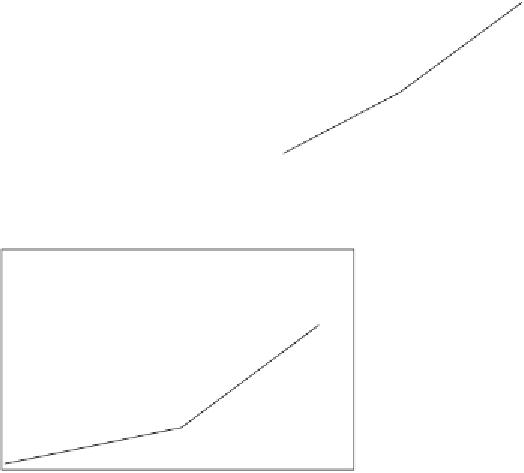Biomedical Engineering Reference
In-Depth Information
0.025
0.014
0.02
0.012
0.015
0.01
0.01
0.008
0.005
0.006
0
0.004
1.6
1.8
2
2.2
2.4
2.6
2.8
2.1
2.2
2.3
2.4
2.5
2.6
2.7
2.8
A
B
Fractal dimension,
D
f
Fractal dimension,
D
fd
5
4
3
2
1
0
0.6
0.7
0.8
0.9
1
1.1
1.2
1.3
C
D
f
/
D
fd
Figure 10.17
(a) Increase in the binding rate coefficient, k, with an increase in the fractal dimension, D
f
.
(b) Increase in the dissociation rate coefficient, k
d
, with an increase in the fractal dimension for the
dissociation phase, D
fd
. (c) Increase in the affinity, K (
k/k
d
), with an increase in the fractal
dimension ratio, D
f
/D
fd.
¼
coefficient,
k
, is very sensitive to the fractal dimension,
D
f
, or the degree of heterogeneity
that exists on the surface as noted by the slightly higher than fifth (equal to 5.06) order of
dependence exhibited.
Figure 10.17b
and
Tables 10.10
and
10.11
show the increase in the dissociation rate coeffi-
cient,
k
d
, with an increase in the fractal dimension,
D
fd
, for a single-fractal analysis. For
the data shown in
Figure 10.1b
, the dissociation rate coefficient,
k
d
, is given by:
D
3
:
96
1
:
83
k
d
¼ð
0
:
000235
0
:
00074
Þ
ð
10
:
11b
Þ
fd
The fit is good. Only three data points are available. The availability of more data points
would lead to a more reliable fit. For a single-fractal analysis, the dissociation rate coeffi-
cient,
k
d
, is very sensitive to the fractal dimension,
D
fd
, or the degree of heterogeneity that
exists on the surface as noted by the slightly less than fourth (equal to 3.96) order of depen-
dence exhibited.


























































